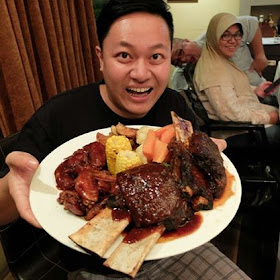Uncovering the dark arts of Pad Thai
It's social media month for Breeze magazine and as foodies, there's a big reason to love social media. Most of the tech-savy population are now turning to social media for the latest news and that includes the latest restaurants, food promotions or product updates. Even a simple step of learning how to cook has evolved, thanks to social media and the internet. No longer do we need to clip recipes from newspaper articles, magazines or books. We can just search through a huge collection of blog posts from fellow home chefs or even professional chefs to learn more about cooking certain dishes!
Say hello to Movember month!
My quest for pad thai came when I posted a picture of a Pad Thai dish I had in a restaurant on Instagram. People were craving for pad thai and wished they could make this dish in their own home. I had to be honest. There had been many disappointing pad thai dishes served in restaurants - too soggy, too sticky or too sweet. To serve a good pad thai dish would require knowledge and research.
Using social media allows me to read through a lot of good information from other food bloggers and learn how to cook Pad Thai. Chez Pim's article on the basics of Pad Thai is very informative and has encouraged many other food bloggers to attempt their variations of Pad Thai. To complement my research, I also read up David Thompson's Thai Cook Book and Cook's Illustrated as well. After all the research, here are tips on how to cook a good Pad Thai in your very own kitchen.
The first ingredients you need would be rice sticks (flat shape and dehydrated), usually available in supermarkets. I chose the ones from Thailand. You would also need tamarind, an essential flavour of traditional pad thai. Palm sugar is better, but brown sugar is acceptable as well, take into account brown sugar will be sweeter and portions need to be adjusted. Fish sauce should be used instead of oyster or soy sauce. Ground thai chili powder (made from thai dried chilies) will be added as well.
Rice sticks can usually be bought from supermarkets in dried form
The first step is to make the sauce. A good pad thai requires you to quickly stir fry your noodles. If you season the noodles bit by bit, it would result it soggy and sticky noodles. The best way is to cook and mix your sauce beforehand. It's logical when you visit the streets of Thailand, hawkers usually just ladle the pre-made sauce onto their woks while cooking pad thai. According to Chez Pim, about 1/2 cup of fish sauce, 1/2 cup of tamarind water, 1/2 palm sugar, less if you're using brown sugar. You cook these three together, and add the chili powder to adjust your level of spiciness. Make sure it's not too sweet, so add your palm sugar slowly - sometimes even 1/4 cup is sufficient. Once you're satisfied with your sauce, you prepare the other ingredients.
Image from thekitchn – For more info on how to use tamarind paste – please click here.
The second step is to prepare the other ingredients. Generally, you should have roasted ground peanuts, ground dried shrimp, pickled radish, cilantro, beansprouts and lime. You would also need your protein of choice; shrimp, fish slices, chicken, pork, beef or tofu. For mine, I decided to use Lap Cheong (Chinese Pork Sausages) because I love them. Shrimp and fish slices cook very fast unlike chicken, pork and beef, which should be cooked before adding to the noodles.
Research shows that some people tried to boil the rice sticks but they ended up too soggy. Some suggested soaking them in tap water overnight but I find it too tedious. Cook's illustrated idea of soaking the rice sticks in warm water for 10-15 minutes yield the best texture. So soak them in hot water for around that time and you should reach a good texture for your stir fry. NOTE: Some brand of noodles requires only 3-5 minutes soaking so be wary of the texture while soaking!
Various brands of fish sauces ~~
To fry your Pad thai - make sure your wok is smoking hot before you add your oil. This dish requires a lot of oil, so don't be shy with it. I never said it's going to be a healthy dish. Add the tofu or meats now and stir fry with a bit of the sauce. Toss in the noodles and stir fry (about two handfuls), making sure they don't clump or stick together. Add about 1/4 cup of the sauce and keep frying. Add more sauce and water as necessary - this requires experience and judgement so you're on your own here!
Dried shrimp that is pounded, instead of using a food processor adds flavour and texture to your pad thai ~~
When your noodles are about ready, push them aside and crack an egg onto the wok, let it cook for a few seconds then mix in your peanuts, pickled radish, dried shrimps. Keep stir frying and then serve on a plate - with cilantro, beansprouts on the side, a lime wedge and ground chilies and extra ground peanuts. Your Pad Thai is done!
Put the condiments on the side for your guests to adjust their pad thai flavour ~~sugar, ground peanuts, ground shrimp, chili powder and lime wedge
If you have a lot of guests - do not try to cook a huge portion at once. It's always better to cook in small portions. This would result in a sticky clumpy mess, that's difficult to control flavour and texture. Serve them two by two - hawker style.
There's no fixed recipe here - just a good basic guide on pad thai. It's up to you to gauge what flavours you like and create your own style. By following these fundamental tips. I can assure you - a Pad Thai chef is born (of course it takes quite a lot of practice and tasting to perfect it!)















No comments :
Post a Comment